 Java
Java javaTutorial
javaTutorial How to design a Java switch grocery shopping system with product classification function
How to design a Java switch grocery shopping system with product classification function
How to design a Java switch grocery shopping system with product classification function
1. Introduction
With the continuous development of technology, online shopping has become a part of people’s lives. an essential part. As one of the important types, the grocery shopping system provides people with a more convenient and faster shopping method. In the process of designing a grocery shopping system, the design of the product classification function is particularly important. It can help users quickly find the products they need and improve the user experience. This article will introduce how to use Java to develop a grocery shopping system with product classification function.
2. Functional requirements analysis
1. User registration and login: Users need to register an account to use the grocery shopping system, and can use this account to log in to the system.
2. Browse products: Users can browse products in different categories through the system and view product details.
3. Product classification: The system needs to provide multi-level product classification, and users can select the corresponding classification to view products according to their own needs.
4. Shopping cart management: Users can put the products they want to buy into the shopping cart, and can add, delete, and modify the items in the shopping cart.
5. Order placement and settlement: Users can select the items in the shopping cart to place an order and make settlement payment.
6. Order management: Users can view their order information, and can cancel and refund orders.
3. Technical design
1. Database design:
In order to store relevant information such as users, products, orders, etc., we need to design corresponding database tables. The following is a simplified design example:
-
User table (user)
- User ID (id)
- User name (username)
- Password (password)
-
Product list (product)
- Product ID (id)
- Product Name (name)
- Product price (price)
- Product category ID (category_id)
-
Product category table (category)
- Category ID (id)
- Category name (name)
- Parent category ID (parent_id)
-
Shopping cart table (cart)
- Shopping cart ID (id)
- User ID (user_id)
- Product ID (product_id)
- Product Quantity
-
Order table(order)
- Order ID(id)
- User ID(user_id)
- Order amount (amount)
- Order time (order_time)
Developed using Java language For the backend, choose an appropriate development framework (such as Spring, Spring MVC, etc.) and develop according to the MVC model.
- User registration and login:
- User registration: The user enters the user name and password, and the system saves them to the user table.
- User login: The user enters the user name and password, and the system queries the user table to verify the login information.
- Product browsing and classification:
- Query products: According to the category ID selected by the user, query the product table, obtain the product list and return it to the front-end display .
- Query classification: Query the classification table, obtain all classification information and return it to the front-end for display.
- Shopping cart management:
- Add products: The user selects the product and determines the quantity, and saves the product ID and quantity to the shopping cart table.
- Delete product: Delete the corresponding product entry from the shopping cart table based on the product ID.
- Modify product quantity: Update the corresponding product quantity in the shopping cart table based on the product ID.
- Order placement and settlement:
- Order placement: The user selects the items in the shopping cart, generates an order record, and calculates the order amount.
- Settlement and payment: The user selects the payment method and makes the payment.
- Order management:
- Query orders: Query the order table according to the user ID, obtain the order list and return it to the front-end display.
- Cancel order: Update the order status to canceled based on the order ID.
- Refund: Perform refund operation based on order ID.
Use front-end technologies (such as HTML, CSS, JavaScript, etc.) to develop and interact with the back-end to implement system functions.
- User registration and login: Provide corresponding registration and login pages, where users enter information and interact with the backend.
- Product browsing and classification: display the product classification list and query the product list according to the category selected by the user.
- Shopping Cart Management: Displays the list of products in the shopping cart and provides addition, deletion and modification functions.
- Ordering and settlement: The user selects the items in the shopping cart to place an order and pay.
- Order management: Displays the user’s order list and provides cancellation and refund functions.
After completing the development of the system, system testing needs to be carried out, including functional testing, performance testing, etc. Make corresponding modifications and optimizations based on the test results to ensure the stability and reliability of the system.
5. Summary
This article introduces how to use Java to develop a grocery shopping system with product classification function. Through reasonable technical design and development processes, functions such as user registration and login, product browsing and classification, shopping cart management, order settlement, and order management can be realized to provide a user-friendly shopping experience. Of course, in addition to the product classification function, the grocery shopping system can also further improve the user experience by introducing search functions, recommendation systems, etc. I hope this article can provide some help to Java developers when designing a grocery shopping system.
The above is the detailed content of How to design a Java switch grocery shopping system with product classification function. For more information, please follow other related articles on the PHP Chinese website!
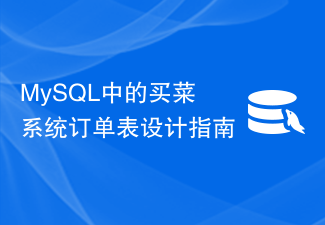 MySQL中的买菜系统订单表设计指南Nov 01, 2023 am 11:53 AM
MySQL中的买菜系统订单表设计指南Nov 01, 2023 am 11:53 AMMySQL中的买菜系统订单表设计指南随着电子商务的兴起,买菜系统也越来越受欢迎。为了满足用户的需求,设计一个高效可靠的订单表是非常重要的。本文将就MySQL中买菜系统订单表的设计进行详细的指南,并提供具体的代码示例。一、订单表设计需求分析订单基本信息:包括订单编号、用户ID、下单时间、订单金额等。订单状态:订单状态分为待支付、已支付、已发货、已完成、已取消等
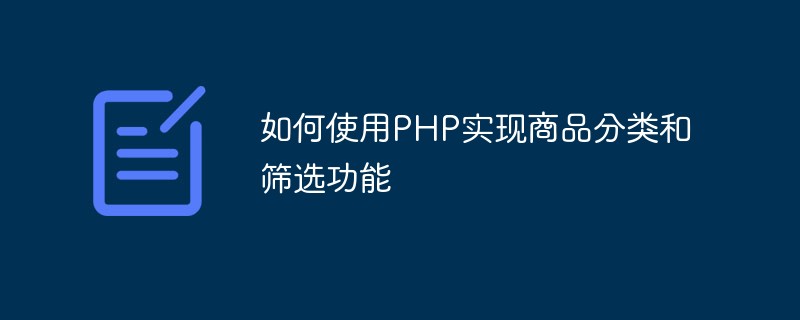 如何使用PHP实现商品分类和筛选功能May 21, 2023 pm 10:51 PM
如何使用PHP实现商品分类和筛选功能May 21, 2023 pm 10:51 PM随着越来越多的电子商务平台的出现,商品分类和筛选功能成为了一个成功的商业网站所必须的基本功能之一。在本文中,我们将介绍如何使用PHP实现商品分类和筛选的功能,让您的网站能够更加方便和易于使用。一、商品分类定义商品分类首先,你需要对商品进行分类。为了实现商品分类,您可以在数据库中定义一个商品类别表。此表包含类别的唯一标识符(ID)和类别名称。例如,您可以在数据
 建立MySQL中买菜系统的用户收货地址表Nov 01, 2023 am 11:03 AM
建立MySQL中买菜系统的用户收货地址表Nov 01, 2023 am 11:03 AM建立MySQL中买菜系统的用户收货地址表,需要具体代码示例在开发一个买菜系统时,用户的收货地址是非常重要的一部分,需要一个独立的数据库表来存储用户的收货地址信息。在MySQL中,可以使用CREATETABLE语句创建一个用户收货地址表。首先,我们创建一个名为"address"的数据库,然后在该数据库中创建一个名为"user_address"的表来存储用户收
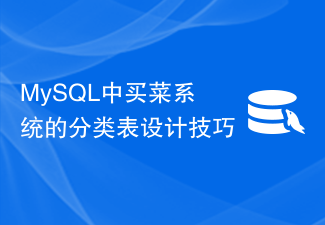 MySQL中买菜系统的分类表设计技巧Nov 01, 2023 am 09:42 AM
MySQL中买菜系统的分类表设计技巧Nov 01, 2023 am 09:42 AMMySQL中买菜系统的分类表设计技巧引言:在购买食品的过程中,分类是十分重要的。对于一个买菜系统来说,分类表的设计是十分关键的一步。本文将介绍在MySQL中设计买菜系统的分类表的技巧,并提供具体的代码示例。一、分析需求在设计分类表之前,我们需要先分析需求,确定分类的层级结构和属性。对于一个买菜系统而言,可以考虑的分类包括:食材、菜品、厨房用具等。这些分类又可
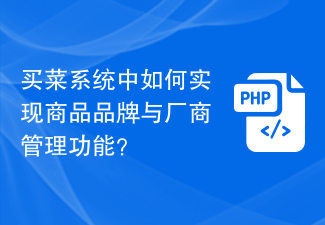 买菜系统中如何实现商品品牌与厂商管理功能?Nov 01, 2023 am 09:05 AM
买菜系统中如何实现商品品牌与厂商管理功能?Nov 01, 2023 am 09:05 AM买菜系统中如何实现商品品牌与厂商管理功能?随着互联网和电子商务的快速发展,买菜系统成为越来越多人选择购物的方式。在这样一个系统中,商品的品牌与厂商管理是非常关键的一环。本文将探讨如何在买菜系统中实现商品品牌与厂商管理功能。首先,买菜系统需建立一个完善的商品品牌数据库。这个数据库可以包含所有的商品品牌信息,如品牌名称、品牌描述、品牌logo等。为了更好地管理品
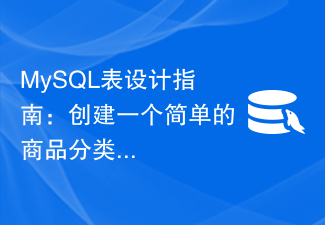 MySQL表设计指南:创建一个简单的商品分类表Aug 03, 2023 pm 02:28 PM
MySQL表设计指南:创建一个简单的商品分类表Aug 03, 2023 pm 02:28 PMMySQL表设计指南:创建一个简单的商品分类表在数据库设计中,良好的表设计是非常重要的,它直接影响到数据的存储和查询效率。本文将介绍如何创建一个简单的商品分类表,并提供相应的代码示例。一、表结构设计商品分类表主要包括以下字段:分类ID、分类名称、父分类ID。其中,分类ID是表的主键,分类名称存储分类的名称,父分类ID用于表示当前分类的父级分类。下面是商品分类
 如何利用PHP开发买菜系统的会员积分功能?Nov 01, 2023 am 10:30 AM
如何利用PHP开发买菜系统的会员积分功能?Nov 01, 2023 am 10:30 AM如何利用PHP开发买菜系统的会员积分功能?随着电子商务的兴起,越来越多的人选择在网上购买日常生活所需,其中包括买菜。买菜系统成为了许多人的首选,其中一个重要的功能就是会员积分系统。会员积分系统可以吸引用户并增加其忠诚度,同时也可以为用户提供一种额外的购物经验。在本文中,我们将讨论如何利用PHP开发买菜系统的会员积分功能。首先,我们需要创建一个会员表来存储用户
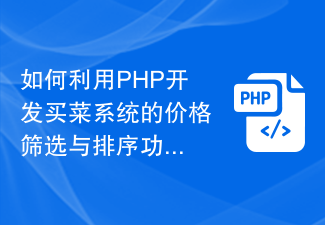 如何利用PHP开发买菜系统的价格筛选与排序功能?Nov 01, 2023 pm 12:58 PM
如何利用PHP开发买菜系统的价格筛选与排序功能?Nov 01, 2023 pm 12:58 PM随着物流和信息技术的发展,网上购物已经成为了日常生活中不可或缺的一部分。其中,生鲜买菜也开始转向线上购买,由此衍生出了买菜系统。在买菜系统中,价格筛选与排序功能是用户选择商品的重要因素,因此本文介绍如何利用PHP开发买菜系统的价格筛选与排序功能。一、设计数据库在买菜系统中,商品信息需要存储在数据库中。因此,我们需要先设计数据库中商品信息的表结构。买菜系统中商


Hot AI Tools

Undresser.AI Undress
AI-powered app for creating realistic nude photos

AI Clothes Remover
Online AI tool for removing clothes from photos.

Undress AI Tool
Undress images for free

Clothoff.io
AI clothes remover

AI Hentai Generator
Generate AI Hentai for free.

Hot Article

Hot Tools

SublimeText3 Mac version
God-level code editing software (SublimeText3)

PhpStorm Mac version
The latest (2018.2.1) professional PHP integrated development tool

WebStorm Mac version
Useful JavaScript development tools

ZendStudio 13.5.1 Mac
Powerful PHP integrated development environment

MinGW - Minimalist GNU for Windows
This project is in the process of being migrated to osdn.net/projects/mingw, you can continue to follow us there. MinGW: A native Windows port of the GNU Compiler Collection (GCC), freely distributable import libraries and header files for building native Windows applications; includes extensions to the MSVC runtime to support C99 functionality. All MinGW software can run on 64-bit Windows platforms.




